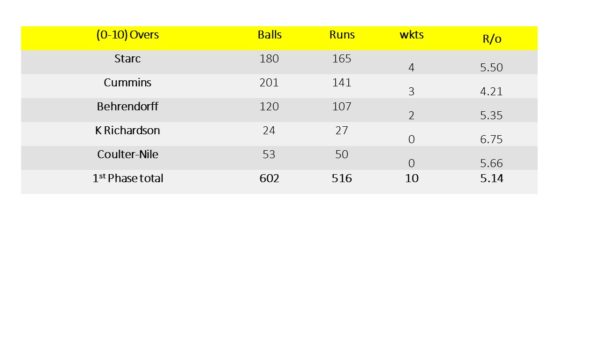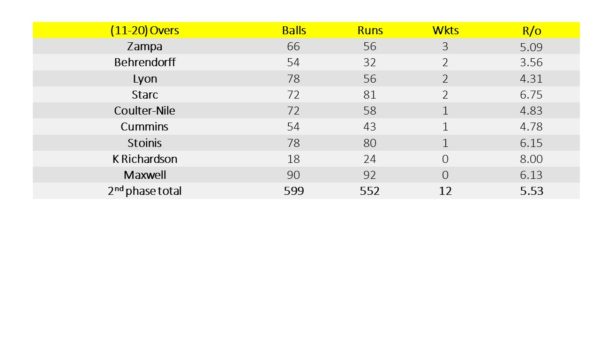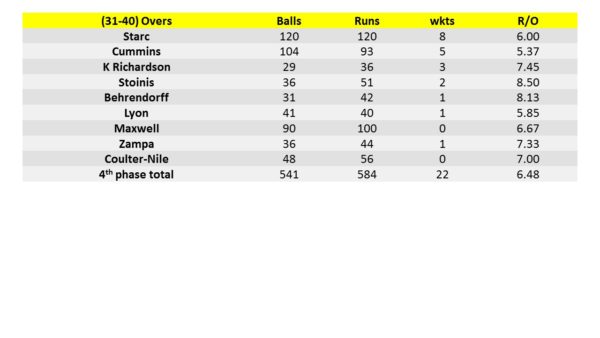Australia’s Performance Review
Prior to World Cup there was a concern with Australia’s batting, especially in middle-order. In limited over match if opening stand is 50 plus then teams usually end up scoring a decent and defendable total. Australia had 6 fifty plus partnerships in this WC, the most for any team and they won 5 of their 6 matches with high partnerships.
However they had to struggle in middle order whenever their openers failed to post solid 1st wkt stand. Below is table of partnerships list for Australia and against Australia.
Batting Order – regular changes in middle order
The opening pair of Finch Warner scored 1154 runs between in them, which is 39.78 % of total runs scored by team.
The No. 3 scored 420 runs with Khawaja scoring(256)Runs in 7 inns, and Smith scoring 164 in 3 Inns, the major contributors.
The bottle-neck problem with No. 4 and No.5
The No.4 – tallied 312 runs (10 inns) –with major contribution by S Smith scoring 214 in 6 Inns. The other 4 inns was between Maxwell 52/2, Khawaja 42/1 and Handscomb 4/1.
The No.5 –tallied 219 runs (10 inns) with majority play by Maxwell scoring 90 in 5 Inns. The other 5 Inns was played by Stoinis 60/3, Carey 46/1 and S Marsh 23/1.
This not only indicates lack of runs scored in these positions, but regular batting change for players!.
Due to injury both S Marsh and U Khawaja were ruled out before semi-finals, which gave them less time to repair their middle-order. Peter Handscomb who replaced Khawaja lasted 12 balls in semi-finals!.
One feels Australia need to fill in fresh players for both these spot, or have Alex Carey at No.5. The No.4 and 5 need to bat out 50-over irrespective what the situation is!.
Players like Maxwell, Stoinis are unable to bat for long innings, and their power-hitting innings are not regular!. In this World Cup they both lasted less than 20 balls/Inns. In terms of partnerships, Stoinis was only involved in one 50 plus partnerships, and Maxwell none!.
However it was their bowling that led them down in this World Cup. It was like hot and cold!. It seems all of them had a similar role of being a strike bowler.
Interestingly they along with England and New Zealand were able to pick all 10 wickets in 5 matches….. the most by any teams. At same time Australia also conceded 300 plus score on three occasion.
The bowling looked ordinary once they didn’t pick any wickets with the new ball. Most times struggled to keep run-rate down.
The key was variation, which they lacked at the end from their fast bowlers. It was less effective.
Fast bowlers from India, England, New Zealand and to some extent Pakistan all possessed great variation in speed and bounce, with slower ball being their weapon. However Australian strike bowlers(Starc, Cummins and Behrendorff) were less effective and lacked in consistency.
It was surprise to see Australian bowling lacked strategy – they seemed to have general plan, and didn’t have backup plan if it didn’t work. Perhaps their plan was not executed accordingly.
For instance – it was obvious Bairstow-Roy are not very comfortable against orthodox spin first up. Australia never used them when defending low target of 224!.
In defending low targets teams can only win if they are able pick wickets from onset. It seems England openers are cautious when spinners are introduced first-up.
Here is how England openers batted against spin in each phase of this tournament.
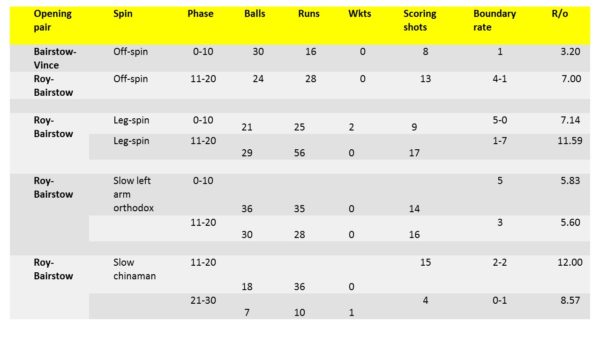 |
In semi-final Australia used Lyon in the 11th over, when score was 50/0 – It was too late for them to make a comeback, and England never slipped!.
Statistical Analysis
ODIs – 10
Won – 7
Lost -3
Key Performance Indicator (KPI)I comparison of (WC-2019) v/s Recent(pre WC -2019). In this WC almost every team had maximum No. of >=6 runs/over – Australia was no exception.
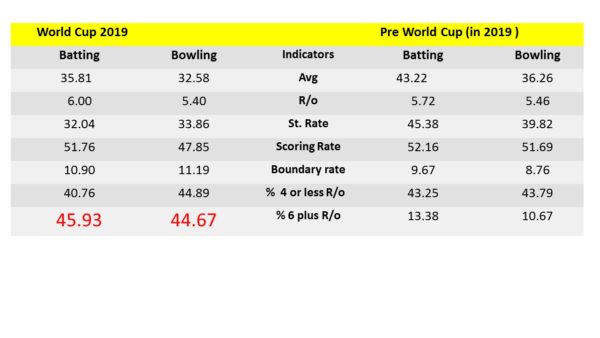 |
Partnerships Avg(Bat v Bowl) with No.century stands(in bracket)
Batting Partnerships –
Australia maintained their high standards for their 1st wicket. Prior to WC captain Finch hand Carey and Usman Khawaja as his opening partners this year. They settled with Khawaja and together they had outstanding partnerships. In 10 matches played just before WC Finch-Khawaja had racked up 817 runs!
Featuring 7 fifty plus including 3 x 100 plus. The trend continued in this WC when David Warner came back. In 10 matches he and Finch piled on 666 runs
Featuring 6 fifty plus including 3 x 100 plus. However it was their middle order (4th and 5th wkt) that has been inconsistent in putting substantial partnership. They have been constantly changing their batting order with different players. There were 4 players used at No.4 and No. 5 and 5 players at No.6. Perhaps they should have settled out their order in first 2 games or prior to WC –
Batting Partnerships against Australia
Interestingly prior to this WC – teams averaged 25.84 for opening stand against Australia, featuring only one 50 plus (193 by India)in 13 ODIs of 2019.
However in this WC Australian the opening stand is 50.60 featuring 3 century stand by India, Sri Lanka and England!. This was followed by few solid partnerships for 2nd wkt and 3rd wkt. It was not that their bowling was poor, as they were able to pick all 10 wickets in 5 of their 10 games, but rest of those games, they bowled poorly!.
 |
Batting stats
Bottle neck in middle order. Maxwell role needs to be defined!
In partnerships table(above) we saw the start given by their openers. It was solid a foundation. This allowed them to post big scores regularly. Interestingly their scoring rate in first 10-overs was very low, probably to avoid any top-order collapse. This they have been maintaining for sometime now.
Maxwell batting form should be a worrying factor for Australia. He currently is the best fielder in the world and saves at least 10 plus and creates more oporutnity to pick a wicket runs/inns. However his inability to bat long has dented Australian middle-order.
He does not stick around!.
In 10 inns this WC he didn’t not score a single 50 run and neither was involved in 50 plus partnership!.
Before this WC in 12 Inns he was involved in four 50 partnership. It might look less but was in great form scoring 458 in those 12 inns against Ind/Pak.
 |
|---|
| 2019 Batting Performance |
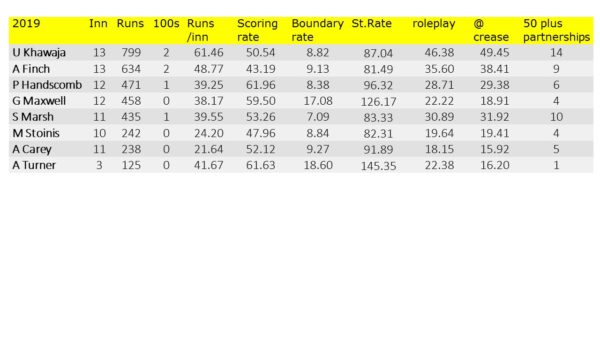 |
10-over phases(bat v bowl)
Here is a 10-over breakdown on their batting and bowling progress. Featuring 6 indicators, including exclusively 6 plus R/o for batting and L 4(4 or less R/o) for bowling. |
|---|
 |
Bowling stats
Strike bowlers need to become a stock bowler
From these stats below it does not look that they bowled badly, but they lacked in strategy and selection of bowlers for each game. Australia erred in not picking Nathan Lyon for their initial games of the WC. They were playing Asian teams at first half of WC and Lyon performed commendable against Ind/Pak in 2 series which they played before WC. If one has to compare Lyon and Zampa – Zampa can be your surprise weapon who can purchase wickets at end(inspite going for boundaries). However Lyon cannot purchase wickets by conceding runs. He picks wickets by adding pressure, by bowling consecutive maidens or less runs. In ODI he can contain and finish his quota of 10 overs before half stage of the innings. His fielding is added skill that can be used.
Bowling comparison WC 2019 - Pre WC 2019
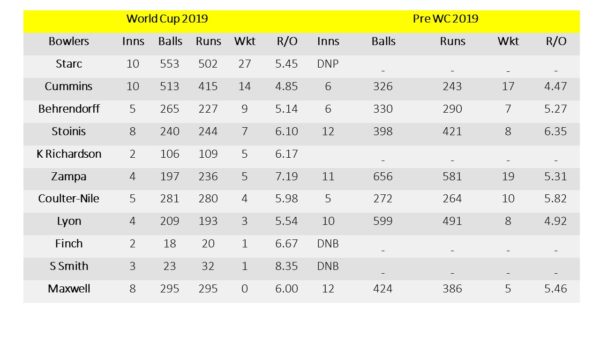 |
Although they were not able to pick regular wickets at the top(see partnerships table) they were able to maintain their standard of run-rate. However it got worse in last 20-overs as their boundary rate increased and L 4 (<= 4 R/o) dropped considerably.
This is due to those some pretty ordinary bowling in last 2 phase. Here is list of bowlers with basic stats. Usually teams are picking wickets regularly in these phases. However Australia manage only few.
This is due to lack of genuine 4th bowler.
Maxwell and Stoinis are decent bowlers who can break partnerships and at times contain runs, but in last 20 overs of a match, they will find it hard to do either of them!.
In Phase IV – 21 overs were bowled by Maxwell and Stoinis picking 2 wkts. The last phase will produce runs and wickets hence there is no argument, yet their striker bowler to wickets regularly, and apart from Starc none of them were able to pick wickets.
10-over phases for bowlers (1st and 2nd bowl)
I have chosen bowlers who have bowled minimum 3-overs in any phase.
All data updated at end of World Cup 2019

